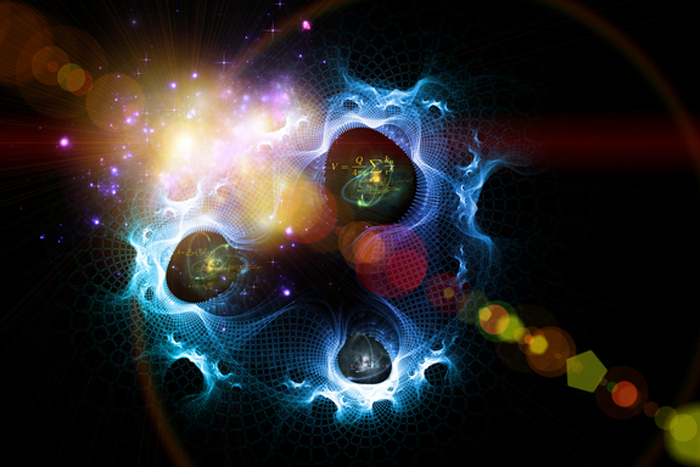Proving Einstein Wrong with 'Spooky' Quantum Experiment

Quantum mechanics is one of the best-tested theories in science, and it's one of the few where physicists get to do experiments proving that Einstein was wrong.
That's what a team at Griffith University and the University of Tokyo in Japan did this week, showing that a weird phenomenon — in which the measurement of a particle actually affects its location — is real.
Back in the 1920s and 1930s, Albert Einstein said he couldn't support this idea, which he called "spooky action at a distance," in which a particle can be in two places at once and it's not until one measures the state of that particle that it takes a definite position, seemingly with no signal transmitted to it and at a speed faster than light. When the particle takes its definite position, physicists refer to this as its wave function collapsing.
The phenomenon was outside of contemporary experience in physics and seemed to violate the theory of relativity, which posits that the speed of light is an absolute limit on how fast any information can travel. Einstein proposed that theparticle isn't in a superposition state, or two places at once; but rather it always has a "true" location, and people just couldn't see it. [How Quantum Entanglement Works (Infographic)]
Using a single photon (particle of light), the Australian and Japanese researchers ran an experiment showing that measuring a property of a quantum particle in one place will affect what one sees in another place. That is, they showed that superposition and collapsing wave function are real phenomena.
Alice and Bob
The phenomenon is demonstrated with a thought experiment in which a light beam is split, with one half going to Alice and the other to Bob. Alice then indicates if she detected a photon and if so what state it is in -- it might be the phase of the wave packet that describes the photon. Mathematically, though, the photon is in a state of "superposition," meaning it is in two (or more) places at once. Its wave function, a mathematical formula that describes the particle, seems to show the photon has no definite position.
Get the world’s most fascinating discoveries delivered straight to your inbox.
"Alice's measurement collapses the superposition," meaning the photons are in one place or another, but not both, Howard Wiseman, director of Griffith University's Centre for Quantum Dynamics, who led the experiment, told Live Science. If Alice sees a photon, that means the quantum state of the light particle in Bob's lab collapses to a so-called zero-photon state, meaning no photon. But if she doesn't see a photon, Bob's particle collapses to a one-photon state, he said.
"Does this seem reasonable to you? I hope not, because Einstein certainly didn't think it was reasonable. He thought it was crazy," he added, referring to the fact that Alice's measurement looked like it was dictating Bob's.
The paradox was partially resolved years later, when experiments showed that even though the interaction between two quantum particles happens faster than light (it appears instantaneous), there is no way to use that phenomenon to send information, so there's no possibility of faster-than-light signals. [10 Implications of Faster-Than-Light Travel]
Splitting photons
The team at Griffith, though, wanted to go a step further and show that the collapsing wave function — the process of Alice "choosing" a measurement and affecting Bob's detection — is actually happening. And while other experiments have shown entanglement with two particles, the new study entangles a photon with itself.
To do this they fired a beam of photons at a splitter, so half of the light was transmitted and half was reflected. The transmitted light went to one lab and the reflected light went to the other. (These were "Alice" and "Bob" of the thought experiment.)
The light was transmitted as a single photon at a time, so the photon was split in two. Before the photon was measured, it existed in a superposition state.
One lab (Alice) used a laser as a reference, to measure the phase of the photon. If one thinks of light as a repeating sine wave, phase is the angle one is measuring, from 0 to 180 degrees. When Alice changed the angle of her reference laser, she got varying measurements of the photon: Either her photon was in a certain phase or it wasn't present at all.
Then the other lab (or Bob) looked at their photons and found the photons were anti-correlated with Alice — if she saw a photon he did not, and vice versa. The state of Bob's photon depended on what Alice measured. But in classic physics that shouldn't happen; rather, the two particles should be independent of one another.
Quantum computing
Akira Furusawa, professor of applied physics at the University of Tokyo and one of the co-authors on the study, said the experiment helps explore different kinds of quantum information processing — and with it, communications and computing.
"Usually there are two types of quantum information processing," he said. "There's the qubit type, the digital information processing, and there's continuous variable, a sort of analog type of quantum information. We are trying to combine them." Conventional processing often relies on counting photons, but this kind of measurement of single photons is more efficient, he said.
Wiseman said one application is in the security of communications.
"Our experiment is a more rigorous test of the properties of such states than has ever been done before, in the sense that we don't have to trust anything that is happening in Alice's laboratory. This could be useful for communicating secrets when not all the parties are trusted."
The experiment is described in the March 24 issue of the journal Nature Communications.
Follow us @livescience, Facebook & Google+. Original article on Live Science.



